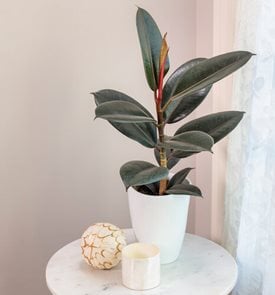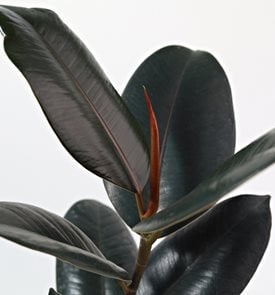How to Grow a Rubber Plant Indoors
When given the right environment and a little TLC, rubber plants can live a long, healthy life in your home.
Chroma® Chloe rubber plant. Photo by: Proven Winners
If you’re old enough to remember the song "High Hopes," first popularized by Frank Sinatra in 1959, the refrain “Oops, there goes another rubber tree plant” is sure to come to mind, humorously describing an ant’s determination to move a large rubber tree all by himself.
With their big, bold leaves and impressive stature, rubber plants (Ficus elastica) are as popular today as they were back in the 1950s. But now houseplant lovers have a much wider array of rubber tree varieties to choose from, including compact versions perfect for desks and tabletops and striking cultivars with multicolored foliage.
Native to tropical regions of Southeast Asia, Ficus have adapted well to indoor environments and will thrive with minimal care as long as you give them plenty of bright light and consistent moisture. Not only are they great plants for adding a tropical vibe to an indoor space, they are also super-efficient air purifiers, using their large leaves to filter out harmful pollutants.
On this page: Basics | Growing Tips | Care | Varieties | Common Problems | FAQs
On this page:
- RUBBER PLANT BASICS
- GROWING RUBBER PLANTS
- RUBBER PLANT CARE
- RUBBER PLANT VARIETIES
- TROUBLESHOOTING COMMON PROBLEMS
BASICS
Botanical name:
Ficus elastica
Common names:
Rubber plant, India rubber plant, rubber tree, rubber fig
Light requirements:
Medium to bright light
Growth rate:
Fast
Size:
In their native tropical habitat, Ficus can reach heights of 50 feet or more. But don’t worry; as houseplants, they rarely grow taller than 10 feet.
Foliage:
Glossy oval-shaped leaves, ranging in size from 5 to over 12 inches long, may be dark green, burgundy, or variegated. Some varieties sport sheathes and midribs in contrasting colors.
Are rubber plants toxic?
Ficus leaves and stems secrete a milky latex sap that is toxic when ingested, so keep out of reach of children and pets. Exposure to the sap may also cause skin irritation in sensitive people. See more Common Poisonous Plants for Dogs and Cats.
GROWING RUBBER PLANTS
Where to grow:
Be sure to place your Ficus in a brightly lit location, such as near an east- or west-facing window or several feet back from a south-facing window. Variegated varieties will benefit from a few hours of direct sun, which will bring out the best foliage color.
Temperature and humidity:
Like its close relative the fiddle-leaf fig, rubber plant loves a warm and humid environment, with temperatures ranging from 60° to 85° F and humidity levels of 40% or higher. Avoid exposing plants to cold drafts or sudden temperature fluctuations. (See more houseplants that like humidity.)
Soil type:
Use a well-draining potting mix with some perlite or orchid bark added to improve drainage and aeration.
Pot requirements:
Plant in a pot about 1 to 2 inches wider than the rootball, with drainage holes to help prevent root rot. To prevent toppling, grow larger rubber trees in a heavy container, or nest a plastic container with drainage holes inside a sturdier one made of clay or ceramic.
Can you grow rubber plant outdoors?
If you live in zones 10-12, you can grow Ficus elastica outdoors year-round in a shady location with filtered sunlight. Keep in mind that they can grow 20 to 30 feet tall outdoors and may need regular pruning to keep it compact.
In colder climates, you can move your indoor rubber tree outdoors in summer once the temperatures warm up, making sure to keep it out of direct sunlight. (Placing the pot on a wheeled caddy will allow you to move it more easily.) Bring your plant back indoors in fall when the temperatures dip below 50° F.

Chroma® Tineke rubber plant, alocasia, and arrowhead plant. Photo by: Proven Winners
RUBBER PLANT CARE
Watering:
Ficus are very particular about their moisture needs and should not be overwatered. Allow the top 2 to 3 inches of soil to dry out between each watering to avoid oversaturation. In winter, when plant growth slows, let the soil go a bit drier. Never allow your rubber tree to sit in standing water.
Fertilizing:
Feed once a month while your plant is actively growing with a liquid houseplant fertilizer diluted to half-strength. You can also add some worm castings to the soil to give your plants a nutritional boost.
Pruning:
If your rubber plant is threatening to outgrow its space, you can keep it in check by pruning the central stem back to a leaf node, which will encourage the growth of side branches. You should also trim off any dead or damaged leaves to keep your plant looking its best and discourage the development of disease. Be sure to wear gloves and long sleeves when handling your plant so you don't get the milky sap on your skin.
Leaf care:
To keep the foliage nice and shiny, wipe it with a damp cloth or sponge as needed to remove dust buildup. Keeping your plant dust-free is good for its health, too, because the leaves will be able to photosynthesize more efficiently. Avoid using leaf shine sprays, which can clog the pores (or stomata).
Repotting:
Rubber plant can shoot up fast under the right conditions and will usually need repotting every 2 or 3 years, or whenever you see the roots begin to grow out of the pot’s drainage holes. The best time to repot is in spring, when your plant emerges from semi-dormancy.
Choose a new container 2 inches larger than the current one and fill it partway with fresh potting mix. Place the top of the plant’s rootball about an inch below the rim and fill in around it with more soil. If your rubber plant has become too unwieldy for repotting, top dress it instead by scooping out the top 2 to 3 inches of soil and replacing it with fresh potting mix.
Tip: If you recently purchased your rubber plant, avoid repotting it for several months to give it time to adjust to its environment. Ficus plants don’t like change and too much stress can cause the leaves to drop.
Propagation:
The easiest method of propagation is by stem cuttings, taken in early spring. Another technique you can try is air layering, which involves rooting a plant stem while it’s still attached to the parent plant. (*See note below on propagating patented plants (check your plant tags for ® or ™ symbols next to the plant name).
Pests and diseases:
Be on the lookout out for common houseplant pests, such as aphids, mealybugs, spider mites, thrips, and scale insects. Rubber plants can also suffer from fungal infections, especially root rot and leaf spot.
RUBBER PLANT VARIETIES
TROUBLESHOOTING COMMON PROBLEMS: RUBBER PLANTS
Even with the best care, a rubber plant may occasionally show signs of distress when it’s unhappy in its environment. Most problems are easy to remedy if you act early to prevent further damage. Here are the most common problems to watch out for and some possible solutions.
- Leaves falling off. If you just brought your rubber plant home from a nursery or moved it to a different room, a sudden loss of leaves may occur until your plant adjusts to its new environment. If your plant hasn’t been moved recently, make sure it’s getting enough sunlight and isn’t being exposed to drafts or temperatures below 55° F.
- Curling of the leaves. Most likely due to inadequate watering or low humidity. If the air in your home is dry, add more humidity by misting the leaves or using a humidifier. Also move your plant away from heat sources and drafts.
- Yellowing leaves. Usually a sign of overwatering. Let the soil dry out some before watering again and make sure to discard any excess water that drains into the saucer. If root rot has set in, you may be able to revive your plant by repotting it in new soil.
- Brown leaf edges. This, too, may be a sign of inadequate humidity, but could also be due to underwatering. Be sure to keep a consistent watering schedule, and never allow the soil to go bone dry. You can remove the browning leaves completely or simply trim off the affected areas with a sharp pair of scissors.
- White spots on the leaves. Tiny, raised white dots on the leaves of ficus plants are common and are nothing more than mineral deposits, called “lithocysts.” While there are no remedies for removing them, they do no harm and actually may enhance photosynthesis by improving light absorption, according to the New York Botanical Garden.
- Leggy appearance. Like other houseplants that need bright light, rubber plants may begin to look leggy and stretch toward the light when they are craving more sun. If possible, move your plant to a spot where it can bask in the sun’s rays for a few hours each day (preferably during the morning to ensure the leaves don't get scorched). Also rotate your plant frequently to prevent lopsided growth. To help keep your plant upright, you may need to support it using a wood or bamboo stake.
*REGARDING PROPAGATION: When it comes to propagating patented plants, there are strict rules in place prohibiting reproduction or propagation of these plants in any way. This means you can't reproduce them (even for use in your own garden), sell them, or bring them into the country without permission. The law does not make exceptions for what some might consider minor infringements. Any unauthorized use of patented plants is considered an infringement.











